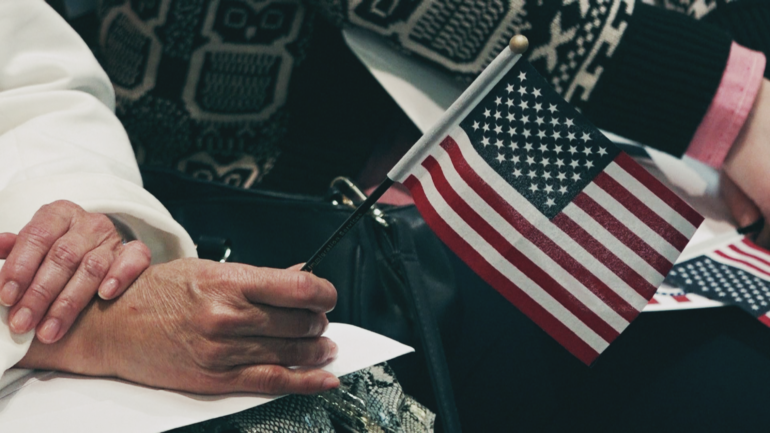The United States is often referred to as a melting pot for its multiculturalism and prides itself on being a nation of immigrants. In 2017, nearly 45 million people living in the United States were born in another country — more immigrants than in any other country.
But the flip side of that diversity is a history of policies that have targeted specific groups of people.
History of Xenophobia
The coronavirus has led to increased reports of harassment against Asian-Americans. This kind of discrimination has long been part of U.S. immigration history.
“One of the persistent myths or charges about immigration has been immigrants don’t assimilate. They’re too many of them. They bring crime. They bring disease,” said Erika Lee, author of America for Americans: A History of Xenophobia in the United States.
Lee is one of the nation’s leading immigration historians and a distinguished professor at the University of Minnesota.
She said when new arrivals first stepped foot into the United States, they were subjected to thorough medical tests, the result of fears that immigrants carried diseases that could spread to Americans. Lee said she’s seeing these fears being played out again during the pandemic.
“There seems to be a spread of racist behavior and prejudice that is targeting all Chinese and Chinese-looking people as carriers of this virus rather than through a more scientific lens in terms of how germs get passed through contact,” Lee said. “That’s a troubling echo from some of the earlier rhetoric and policies of the past.”
The Chinese were the first ethnicity or nationality to be banned in the United States. The Chinese Exclusion Act of 1882 barred Chinese immigration to the country and prevented Chinese nationals already in the country from becoming U.S. citizens.
Lee’s own family history has roots in this dark period. One grandfather had to assume the identity of someone else and pay exorbitant fees in order to come to the United States while the Act was still in place.
“He passed that test, but only after a humiliating experience with medical exams, two weeks of detention at the immigration station on Angel Island, and then a lifetime of living in the shadows as an undocumented immigrant,” Lee said.
What Lee says she finds encouraging about American society now is the amount of public protest and organizing around immigration policies that have targeted particular groups.
“As a historian, I do feel like we’re at a tipping point,” she said.
Changing the Narrative
Many Muslims say they’ve been targeted by U.S. immigration policies and societal discrimination, most notably after the terrorist attacks on Sept. 11, 2001
“Whoever looks Muslim-y is a threat,” said journalist, writer and playwright Wajahat Ali.
“The globalization of this narrative is literally the propaganda and recruitment of ISIS,” he said. “The West is at war with Islam. And extremists here say Islam is at war with the West. It’s a brand–new ballgame.”
Ali says “overwhelmingly negative” media portrayals of Muslims have not helped. His 2005 play, The Domestic Crusaders, features a Muslim-American family from Pakistan navigating a post-9/11 world.
Ali said, “The cultural production is a key way for us to humanize our narratives and to appeal to people’s better angels.”
Deportation Fears
In his first three years in office, U.S. President Barack Obama deported 1.18 million immigrants, compared with the 800,000 deportees under President Donald Trump’s first three years. Trump has, however, pushed for stronger enforcement of illegal immigration, including targeting an Obama-era rule that gives temporary legal status to immigrants who came to the country as children.
The program — called Deferred Action for Childhood Arrivals, or DACA — allows some young people who came to the United States as children to get temporary legal status, meaning they are protected from deportation and can get a work permit. The fate of 700,000 DACA recipients rests now on a decision by the U.S. Supreme Court, expected this summer.
Jesus Alberto Lopez, who goes by Beto, came to Chicago from Mexico as a boy with his family. In 2015, he received the temporary protected status under DACA. To maintain that status, recipients must renew every two years. Beto did not renew, and that decision proved to be devastating.
In May of 2019, Beto was headed back to Chicago from Colorado on a hiking trip with friends. Police stopped their car for speeding, and Beto was taken into immigration custody for not having a legal immigration status.
“I don’t know what’s going to happen, you know. I don’t know how long or nothing,” said Beto, who had never been in jail before.
Beto’s older brother, Miguel, also a DACA recipient, said he and their family thought Beto’s incarceration would be short because Beto was eligible for legal status. But months passed, and the threat of deportation loomed. Beto was ultimately transferred to four different facilities.
“I think it’s very important to remind that ICE [Immigration and Customs Enforcement] has, since the moment [Beto] was in custody, the discretion to release him without any judge order or anything,” Miguel said. “If they wanted to, they could’ve released him way before this.”
Nine months later, and after filing a federal lawsuit against ICE, Beto was released. But given the uncertain future of DACA, Beto doesn’t know if he will still be deported.
“I will say that your borders are all mental,” he said. “There’s not a physical border that separates us.”
 CGTN America
CGTN America
